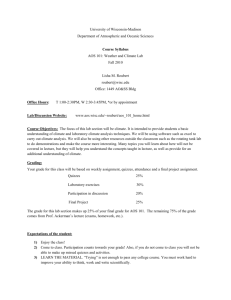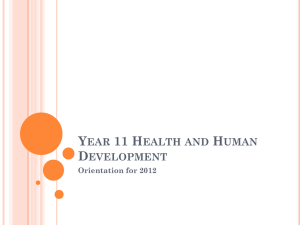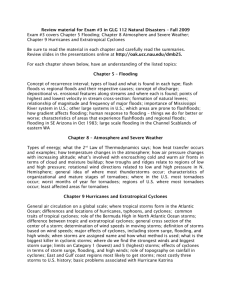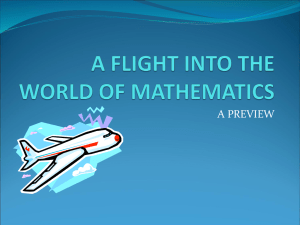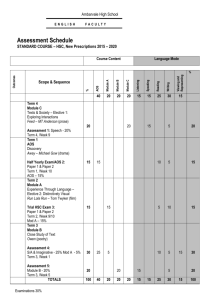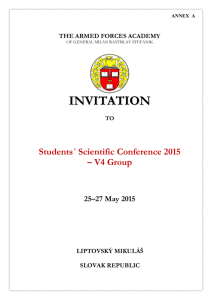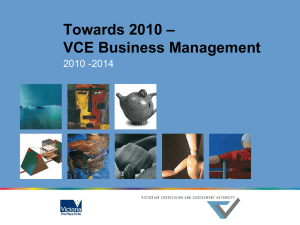AOS 100/101: Severe Weather & Climate Syllabus - University of Wisconsin
advertisement
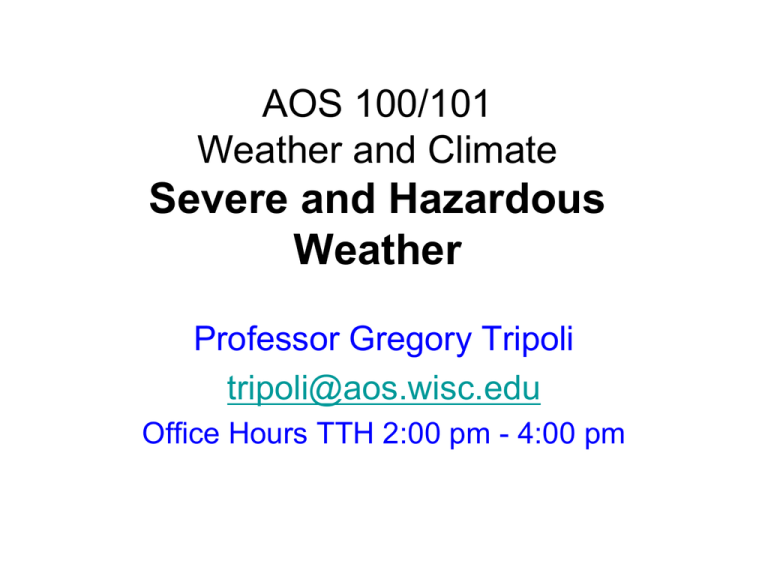
AOS 100/101 Weather and Climate Severe and Hazardous Weather Professor Gregory Tripoli tripoli@aos.wisc.edu Office Hours TTH 2:00 pm - 4:00 pm Teaching Assistants TAs •Stephen Ogden (Class TA, Grader) • • AOS 100 TA AOS 100/101 grader (Homeworks, cloud project) •Ross Dixon (Lab Instructor) • AOS 101-1 (M 9:55 am – 10:45 am) •Kuni Inoue (Lab Instructor) • AOS 101-2 T 1:20-2:10 pm •Archana Shrestha (Lab Instructor) • • AOS 101-3 (W 12:05 pm-12:55 pm) AOS 101-4 (TH 11:00 am – 11:50 am) Please Let Me Introduce Myself • • • • Gregory J Tripoli Born Cleveland, Ohio, 1950 Lived on the shores of Lake Erie until 1966 Became interested in weather for purposes of forecasting: – future weather affecting fishing conditions on the Lake – Snow sufficient to cancel school Professional Background? • Fireman/engineer, Penn Central Railroad, NYC? (1970-1971) • Seminole? (BS, MS, FSU, 1969-1974) • Tiger? (Princeton University, 1974-1976) • Ram? (CSU, 1976-1987, PhD, 1986) • Badger (UW professor since 1987) Teacher and Research Meteorologist specializing in basic understanding of convective weather systems through explicit mathematical modeling of physical processes Course Goals • Develop a basic understanding of the Earth’s atmosphere including the role of weather and the legacy of climate • Develop a basic working knowledge of how to diagnose the current state and predict the future state of the atmosphere from online resources • Develop skills to understand, observe and anticipate severe and unusual weather and climate and embrace the awe that it endears Grading for 100 (and lecture portion of 101) Homework Project Test 1 Test 2 Final (cumulative) 20% 15% 20% 20% 25% * If you are taking 100 or 101 for honors credit, please send me an email to this effect so that I have your name and email address. I would like to meet with the group at the end of the class on Monday, September 8, 2014. Grading for 101 Lecture Discussion/Laboratory 75% 25% Basic Lecture Structure • 10-15 minute discussion of current weather, pointing to applications of the current topic…on special occasions, this discussion may take longer or all of the class time • Answer questions from class regarding reading assignment • Lecture designed to expand and embellish selected topics from reading or introduce topics not found in reading Text Book Severe and Hazardous Weather An Introduction to High Impact Meteorology (4th Edition) By Robert M Rauber, John Walsh, Donna Charlevoix Kendall/Hunt Publishing Co., Dubuque, Iowa Material for Which You Will Responsible • The class is divided into 6 subject areas for which lectures are built. • The lecture subject each day will appear in the syllabus. • Dates of when subjects will be covered are estimated in the syllabus now, but will be modified as we move ahead or behind the schedule • Specific text book chapters will be assigned in the syllabus. You are expected to read this material before class. • Lectures will be designed to discuss text book material, but will not cover all of the material presented in the text book. You still are responsible for material not covered unless I specifically say that you are not responsible for certain material. It is your responsibility to ask questions to clarify subjects that you do not understand. • Generally, homework questions will be a good guide to the questions appearing on the tests. Homework • A homework will be assigned every other week • The assignment will be listed on the Lecture Slides available on line • Assignments will consist of: – Problems in the text – Problems based on Lecture material • Homework will be handed in electronically Term Project 1. Clouds and Optical Phenomena Project 1.Managed by Stephen Ogden, 100 TA (sogden@wisc.edu) 2.15% of lecture grade Syllabus I. Introduction 1. 2. 3. 4. 5. 6. 9/3 9/5 9/8 9/10 9/12 9/15 Introduction Cloud Project, identification Atmospheric Variables Measurements Weather Maps Computer Models Ch 1 Ch 2 Ch 3 Ch 4 Syllabus I. Basic Dynamics 7. 8. II. 9/17 9/19 Forces and Balances High, Low Pressure Ch 7 Ch 8 Atmospheric Convection 9. 10. 11. 12. 13. 14. 15. 16. 17. 9/22 9/24 9/26 9/29 10/1 10/3 10/6 10/8 10/10 10/13 10/15 Stability Microphysics Thunderstorms Supercells Tornadoes 1 Tornadoes 2 Hail Lightning Downbursts Review Test 1 Ch 6 Ch 18 Ch 19 Ch 19 Ch 19 Ch 20 Ch 21 Ch 22 Ch 1-4, 6-8, 18-22 Ch 1-4, 6-8, 18-22 Syllabus III. Global Circulation 18. 19. 20. 10/20 General Circulation 10/22 Seasonal Circulations, Monsoons 10/24 Climate Variability Ch 5 Ch 5 Ch 5 IV. Tropical Disturbances 21. 10/27 MJO/Easterly Waves 22. 10/29 Tropical Cyclones 1 23. 10/31 Tropical Cyclones 2 24. 11/3 Monsoon Cyclones 11/5 Review 11/7 Test 2 Ch 24 Ch 24 Ch 24 Ch 5, 24, 9-11 Ch 5, 24, 9-11 Syllabus V. Extratropical Disturbances 25. 26. 27. 28. 29. 30. 31. 11/10 11/12 11/14 11/17 11/19 11/21 11/24 Baroclinic Cyclone 1 Baroclinic Cyclones 2 Baroclinic Cyclones 3 Ice Storms Lake Effect Storms Cold Waves Blizzards Ch 9 Ch 10 Ch 11 Ch 12 Ch 13 Ch 14 Ch 15 VI. Mountain Meteorology 32. 33. 34. 35. 12/1 Mountain Snow Storms 1 12/3 Mountain Snow Storms 2 12/5 Mountain Wind Storms 12/8 Mountain Flooding Storms 12/9 Review 12/11 Review Ch 16 Ch 16 Ch 17 Ch 26 12/17, 2:25pm Final Exam (cumulative) Introducing to Weather and Climate • Radiation from the sun (mostly in the form of visible light) shines on the earth and for the most part passes through the atmosphere on to the surface • Sun shining on surface (2/3 water) has two effects: – Causes water to evaporate – Heats the surface, and heat is conducted into the air Introducing to Weather and Climate • In order for the planet to maintain an equilibrium temperature, the Earth must radiate to space the same amount of heat that it absorbs from the sun • The Earth radiates heat from everywhere • The planet heats and moistens only where the sun shines • Circulations must form to move heat and moisture around, thus causing weather
